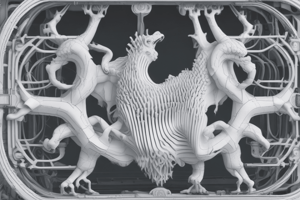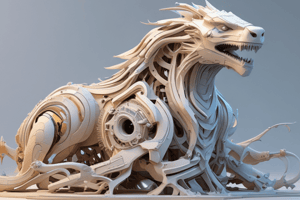Podcast
Questions and Answers
Rapid prototyping is a fabrication technique that uses virtual data to develop prototypes or scaled models.
Rapid prototyping is a fabrication technique that uses virtual data to develop prototypes or scaled models.
True (A)
Rapid prototyping involves printing layers of a CAD model to create a complete 3D prototype.
Rapid prototyping involves printing layers of a CAD model to create a complete 3D prototype.
True (A)
Match the following examples to their respective applications in Additive Manufacturing:
Match the following examples to their respective applications in Additive Manufacturing:
Metal Nut = Form Metal Bolt = Fit Metal Screw = Function
Match the following definitions to their respective applications in Additive Manufacturing:
Match the following definitions to their respective applications in Additive Manufacturing:
Match the following functions with their descriptions in Reverse Engineering software:
Match the following functions with their descriptions in Reverse Engineering software:
Match the functions with their differences in 3D CAD software and Reverse Engineering software:
Match the functions with their differences in 3D CAD software and Reverse Engineering software:
Match the following functions with their operations in Reverse Engineering software:
Match the following functions with their operations in Reverse Engineering software:
The point cloud data is obtained from applying the reverse engineering technique.
The point cloud data is obtained from applying the reverse engineering technique.
Match the following functions with their descriptions:
Match the following functions with their descriptions:
Match the following terms with their meanings in the context of prototype production:
Match the following terms with their meanings in the context of prototype production:
Match the following steps to their position in Additive Manufacturing process:
Match the following steps to their position in Additive Manufacturing process:
Match the following characteristics of Additive Manufacturing technologies:
Match the following characteristics of Additive Manufacturing technologies:
Match the following terms with their descriptions in Solid Ground Curing process:
Match the following terms with their descriptions in Solid Ground Curing process:
Which of the following is an example of a layer-based approach in fabrication other than AM?
Which of the following is an example of a layer-based approach in fabrication other than AM?
Match the countries with their respective major Additive Manufacturing companies:
Match the countries with their respective major Additive Manufacturing companies:
Which term is used to refer to the technology that allows for the direct fabrication of a model without the need for process planning?
Which term is used to refer to the technology that allows for the direct fabrication of a model without the need for process planning?
Which term is commonly used to refer to additive manufacturing?
Which term is commonly used to refer to additive manufacturing?
What is the formalized term for rapid prototyping?
What is the formalized term for rapid prototyping?
Which of the following features can fail in CNC machining if they are beyond a certain limit?
Which of the following features can fail in CNC machining if they are beyond a certain limit?
What is the potential consequence of incorrect programming of a CNC machine?
What is the potential consequence of incorrect programming of a CNC machine?
Which process involves determining the program sequence for a CNC machine?
Which process involves determining the program sequence for a CNC machine?
Which of the following materials is commonly used in CNC machining for shaping softer materials?
Which of the following materials is commonly used in CNC machining for shaping softer materials?
Which of the following materials is CNC machining particularly well-suited for?
Which of the following materials is CNC machining particularly well-suited for?
Which of the following statements is true about the quality of parts produced by CNC machining compared to AM?
Which of the following statements is true about the quality of parts produced by CNC machining compared to AM?
Which of the following is a popular approach to classify AM technologies?
Which of the following is a popular approach to classify AM technologies?
What is the problem with classifying AM technologies according to the type of raw material input?
What is the problem with classifying AM technologies according to the type of raw material input?
Flashcards are hidden until you start studying
Study Notes
Rapid Prototyping and Additive Manufacturing
- Rapid prototyping utilizes virtual data to create prototypes or scaled models.
- Involves layering techniques to print CAD models and generate complete 3D structures.
Applications of Additive Manufacturing
- Specific definitions are matched with their roles in diverse applications of Additive Manufacturing.
- Functions in reverse engineering software are categorized based on descriptions and operations.
Point Cloud Data
- Achieved through reverse engineering techniques, utilized for creating 3D models.
Prototype Production Terminology
- Terms are defined in the context of prototype creation processes, providing clarity on industry language and jargon.
Additive Manufacturing Process
- Various steps within the Additive Manufacturing process are arranged sequentially for better understanding.
Characteristics of Additive Manufacturing Technologies
- Key features of different Additive Manufacturing technologies are examined and matched with their respective characteristics.
Solid Ground Curing Process
- Terms are paired with descriptions specific to Solid Ground Curing, explaining the technology and its applications.
Fabrication Techniques
- Identifies examples of layer-based fabrication approaches outside of traditional Additive Manufacturing.
Major Companies in Additive Manufacturing
- Countries are matched with prominent Additive Manufacturing firms based on industry presence and contributions.
Direct Fabrication Technology
- Refers to methodologies that enable model creation without extensive process planning, enhancing efficiency.
Definitions of Additive Manufacturing
- Common terminologies for additive manufacturing are identified with their formalized definitions.
CNC Machining Insights
- Identify features that can fail beyond specific limits when using CNC machining techniques.
- Incorrect programming can lead to significant operational problems and manufacturing faults.
CNC Programming and Materials
- Program sequence determination is essential for CNC machine operation.
- Softer materials are typically machined using particular materials suited for CNC processes.
Quality Comparisons Between Machining Techniques
- CNC machining generally produces higher quality parts compared to Additive Manufacturing methods.
Classification Challenges in AM Technologies
- Popular methods exist for categorizing Additive Manufacturing technologies.
- Issues arise when classifying based solely on the type of raw material used, suggesting a need for multi-faceted approaches.
Studying That Suits You
Use AI to generate personalized quizzes and flashcards to suit your learning preferences.





